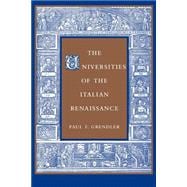
What is included with this book?
Paul F. Grendler is a professor emeritus of history at the University of Toronto, and former president of the Renaissance Society of America. He is the editor-in-chief of the prize-winning Encyclopedia of the Renaissance and author of several books including Schooling in Renaissance Italy, winner of the American Historical Association's Howard R. Marraro Prize for Italian History, also available from Johns Hopkins.
| List of Illustrations | xi | ||||
| List of Tables | xiii | ||||
| Preface | xv | ||||
| Abbreviations | xix | ||||
| PART I. THE UNIVERSITIES OF ITALY | |||||
|
3 | (38) | |||
|
3 | (2) | |||
|
5 | (9) | |||
|
14 | (7) | |||
|
21 | (10) | |||
|
31 | (10) | |||
|
41 | (29) | |||
|
41 | (4) | |||
|
45 | (11) | |||
|
56 | (8) | |||
|
64 | (6) | |||
|
70 | (39) | |||
|
70 | (7) | |||
|
77 | (5) | |||
|
82 | (11) | |||
|
93 | (6) | |||
|
99 | (7) | |||
|
106 | (3) | |||
|
109 | (34) | |||
|
109 | (8) | |||
|
117 | (4) | |||
|
121 | (5) | |||
|
126 | (11) | |||
|
137 | (3) | |||
|
140 | (2) | |||
|
142 | (1) | |||
|
143 | (56) | |||
|
143 | (8) | |||
|
151 | (1) | |||
|
152 | (5) | |||
|
157 | (2) | |||
|
159 | (7) | |||
|
166 | (3) | |||
|
169 | (3) | |||
|
172 | (6) | |||
|
178 | (2) | |||
|
180 | (3) | |||
|
183 | (3) | |||
|
186 | (13) | |||
| PART II. TEACHING AND RESEARCH | |||||
|
199 | (50) | |||
|
199 | (6) | |||
|
205 | (4) | |||
|
209 | (5) | |||
|
214 | (8) | |||
|
222 | (3) | |||
|
225 | (4) | |||
|
229 | (7) | |||
|
236 | (5) | |||
|
241 | (6) | |||
|
247 | (2) | |||
|
249 | (18) | |||
|
250 | (3) | |||
|
253 | (4) | |||
|
257 | (6) | |||
|
263 | (3) | |||
|
266 | (1) | |||
|
267 | (47) | |||
|
269 | (2) | |||
|
271 | (8) | |||
|
279 | (2) | |||
|
281 | (12) | |||
|
293 | (4) | |||
|
297 | (13) | |||
|
310 | (4) | |||
|
314 | (39) | |||
|
314 | (4) | |||
|
318 | (6) | |||
|
324 | (4) | |||
|
328 | (4) | |||
|
332 | (2) | |||
|
334 | (7) | |||
|
341 | (1) | |||
|
342 | (9) | |||
|
351 | (2) | |||
|
353 | (40) | |||
|
353 | (4) | |||
|
357 | (3) | |||
|
360 | (6) | |||
|
366 | (6) | |||
|
372 | (9) | |||
|
381 | (3) | |||
|
384 | (1) | |||
|
385 | (2) | |||
|
387 | (2) | |||
|
389 | (4) | |||
|
393 | (15) | |||
|
393 | (2) | |||
|
395 | (3) | |||
|
398 | (5) | |||
|
403 | (5) | |||
|
408 | (22) | |||
|
408 | (5) | |||
|
413 | (2) | |||
|
415 | (11) | |||
|
426 | (1) | |||
|
427 | (3) | |||
|
430 | (47) | |||
|
431 | (3) | |||
|
434 | (2) | |||
|
436 | (7) | |||
|
443 | (4) | |||
|
447 | (10) | |||
|
457 | (3) | |||
|
460 | (5) | |||
|
465 | (4) | |||
|
469 | (3) | |||
|
472 | (5) | |||
| PART III. RECESSIONAL | |||||
|
477 | (32) | |||
|
477 | (2) | |||
|
479 | (4) | |||
|
483 | (1) | |||
|
484 | (2) | |||
|
486 | (5) | |||
|
491 | (4) | |||
|
495 | (2) | |||
|
497 | (1) | |||
|
498 | (2) | |||
|
500 | (5) | |||
|
505 | (3) | |||
|
508 | (1) | |||
| Conclusion | 509 | (4) | |||
| Appendix: Faculty Size and Student Enrollments | 513 | (4) | |||
| Bibliography | 517 | (52) | |||
| Index | 569 |
The New copy of this book will include any supplemental materials advertised. Please check the title of the book to determine if it should include any access cards, study guides, lab manuals, CDs, etc.
The Used, Rental and eBook copies of this book are not guaranteed to include any supplemental materials. Typically, only the book itself is included. This is true even if the title states it includes any access cards, study guides, lab manuals, CDs, etc.